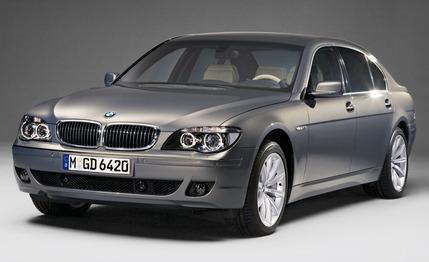
 First Drive Review
First Drive Review
It's muscle-flexing time among the world's carmakers, making for a horsepower race that we haven't seen the likes of since the 1960s. Only this time around, the objects at center stage are 12-cylinder cars with stratospheric price ranges, such as the Mercedes-Benz S600 and its 493-hp, twin-turbocharged V-12, or the upcoming Bentley Continental GT that'll make more than 500 horsepower from a twin-turbocharged W-12 mill. Fat-cat rides simply aren't cool these days unless there are 12 thumping pistons underhood. Even Cadillac has a V-12 in the works.
In the meantime, we recently sampled the newest V-12 from one of the big daddies in the engine biz: BMW. This all-new engine is only available in the U.S. in the long-wheelbase $116,495 760Li.
Its latest street engine, the 6.0-liter DOHC 48-valve all-aluminum V-12, is a billboard of BMW engine technology. There's the Double VANOS system that uses phasers on both the intake and exhaust cams to infinitely vary cam timing. The intake manifold and the valve covers are made from lightweight magnesium rather than aluminum or steel. There's also Valvetronic, a separate but ingenious system that adjusts intake-valve lift, thereby obviating the usual throttle plate and reducing pumping losses.
Both Valvetronic and Double VANOS are also on the V-8 745i and 745Li, but only the V-12 gets a new fuel-injection system, known in the industry simply as direct injection (DI), meaning the fuel injector pokes through the top of the combustion chamber. That may seem like a subtle difference when compared with regular fuel injection, where the injector is mounted outside the combustion chamber and in the intake port. However, conditions inside the combustion chamber are about as welcoming as, well, Hell, with temperatures of more than 1000 degrees Fahrenheit and pressures up to 70 atmospheres.
DI yields a variety of benefits. Fuel can be injected at any time, not only when the intake valve is open. Also, in certain conditions, the injectors pulse twice during a compression-and-combustion event to promote complete burns. BMW's direct fuel injection squirts the gas at very high pressures (between 435 and 1450 psi), which effectively mixes the fuel with the incoming air.
This excellent mixing can allow the engine to run with lean air-to-fuel ratios, which increases gas mileage. But there's a rub: Running lean produces an exhaust that's rich in oxides of nitrogen, and current catalysts can't remove them. New catalysts that can are intolerant of typical high-sulfur U.S. gasoline. So the BMW V-12 doesn't run lean, but it does take advantage of DI's cooling effect (vaporizing fuel removes combustion-chamber heat) to run a high compression ratio (11.3:1). BMW says direct injection increased the engine output by five percent.
Okay, enough techno babble. What kind of power does the big sedan make? Try 438 horsepower at 6000 rpm and 444 pound-feet of torque at 3950 rpm. It's less power than the Mercedes V-12 makes, but that's made with turbocharging. BMW considers turbos or superchargers to be low-tech shortcuts to power, horsepower solutions unfit for a flagship engine. Blowers, they say, add weight and complexity and reduce throttle response. Ask a BMW engineer if the V-12 might one day be turbocharged, and you'll get a scowl and a curt, "Nein!"
After a brief drive in the 760Li, we didn't argue. This new V-12 is pure magic, with a seamless power curve and an extremely satisfying muted roar. Like the V-8-powered 745i/Li, the 760Li uses a six-speed automatic that almost completely masks shifts. The power is so smooth that in some ways the nearly 5000-pound 760Li doesn't feel as fast as it is. We haven't tested one yet, but BMW estimates a scoot to 60 mph will take about 5.4 seconds.
We appreciate BMW's steadfast devotion to the aural and visceral characteristics of a non-turbo engine, and the new V-12 is wonderful. The rest of the car is still a somewhat mixed bag. We love the driving dynamics, but as we've reported before, we're perplexed by the ergonomics and the overly teched iDrive interior-control system. Maybe we simply need more time in one to get used to iDrive. How about a long-term 760Li, BMW?